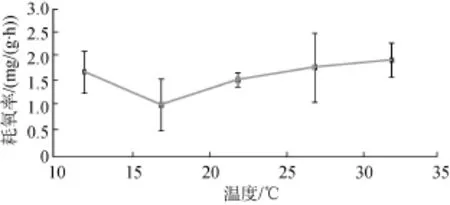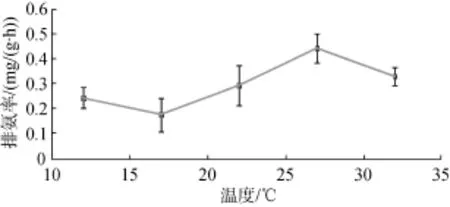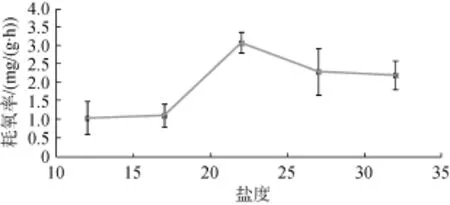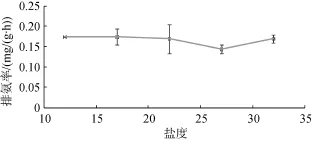不同温度和盐度对大竹蛏耗氧率和排氨率的影响
聂鸿涛, 姜力文, 王海伦 邢宁宁 杨 凤, 闫喜武
(1. 大连海洋大学, 辽宁省贝类良种繁育工程技术研究中心, 辽宁 大连 116023; 2. 大连海洋大学水产与生命学院, 辽宁 大连 116023)
不同温度和盐度对大竹蛏耗氧率和排氨率的影响
聂鸿涛1,2, 姜力文1,2, 王海伦1, 邢宁宁1, 杨 凤1,2, 闫喜武1,2
(1. 大连海洋大学, 辽宁省贝类良种繁育工程技术研究中心, 辽宁 大连 116023; 2. 大连海洋大学水产与生命学院, 辽宁 大连 116023)
在实验室条件下, 设置12、17、22、27和32℃五个温度梯度和12、17、22、27和32五个盐度梯度, 研究了不同温度和盐度对大竹蛏(Solen grandis)耗氧排氨的影响。结果表明: 随着温度的升高耗氧率先降低再逐渐升高, 在温度为22℃时为最小值1.571 mg/(g·h); 排氨率先降低后升高再降低, 在温度17℃时为最小值0.127 mg/(g·h)。随着盐度增加耗氧率先升高后降低, 在盐度22时达到最大值3.106 mg/(g·h), 排氨率先降低再升高, 在盐度为27时为最小值为0.145 mg/(g·h)。在盐度32时, 不同温度的O: N范围是5.525~79.037。在温度12℃时, 不同盐度下的O︰N范围是4.378~16.755。不同温度下耗氧率Q10变化范围为1.054~2.421, 排氨率的Q10变化范围是0.748~1.256。研究结果为进一步完善大竹蛏的人工养殖技术提供参考。
大竹蛏(Solen grandis); 温度; 盐度; 耗氧率; 排氨率
大竹蛏(Solen grandis)在分类上隶属于软体动物门, 双壳纲, 真瓣鳃目, 竹蛏科, 竹蛏属, 分布较为广泛, 是我国重要的经济贝类[1]。大竹蛏市场前景较好, 经济价值高, 因其肉味鲜美深受消费者的喜爱。大竹蛏的出肉率45%, 蛋白质含量高达82.7%[2], 必需氨基酸种类齐全, 具有较高的营养价值[3]。目前,有关大竹蛏的研究主要集中在人工育苗技术[4-8]、繁殖生物学[9-11]、养殖生态学[12-14]和分子生物学[15-17]等方面。
温度和盐度是影响海洋贝类生长发育的关键因素, 也是随季节和气象条件变化而极易发生改变的两个环境因子[18]。目前, 国内外有关贝类耗氧率和排氨率的研究很多, 贝类耗氧率、排氨率、氧氮比及Q10的测定, 可以作为评估外界环境对贝类生理状态影响的重要指标[19]。由于贝类的种类不同, 得到的代谢规律有所不同, 关于双壳贝类耗氧率和排氨率的研究较多[20-23], 但关于大竹蛏耗氧率和排氨率的研究还未见报道。本研究以大竹蛏野生群体为材料, 研究了不同温度和盐度对大竹蛏耗氧排氨的影响, 以期从生理学角度探究大竹蛏的生理特性,明确大竹蛏适宜的温度和盐度范围, 为开展大竹蛏的人工养殖提供基础数据, 从而为大竹蛏苗种规模化培育技术的推广和普及提供理论依据。
1 材料与方法
1.1 大竹蛏和实验用水
实验所用的大竹蛏采购于大连新长兴市场, 本次实验采用的大竹蛏个体健康, 活动性强。实验所用海水为黑石礁海区, 经沉淀、砂滤后储存备用水。实验所用大竹蛏的规格见表1。实验开始前, 先将大竹蛏暂养3 d, 暂养期间不投喂, 水温12℃±0.3℃, 每天换水1次。实验统一都用水质分析仪来测定海水的盐度和pH, 实验所用海水的pH为8.0, 盐度为32。
1.2 实验方法
耗氧率和排氨率的测定方法是, 实验开始前用加热棒和盐度计分别调控温度和盐度, 待温度和盐度调整在设定梯度时, 分别取规格一致的大竹蛏(表1)各2个放入呼吸瓶中, 当每个呼吸瓶中伸出水管的大竹蛏数大于1个计时试验开始, 试验持续3 h。以不放大竹蛏的呼吸瓶作为对照, 全部实验设3个重复。根据始末溶氧变化和氨氮浓度的变化计算耗氧率(OR, mg/(g·h))和排氨率(NR, mg/(g·h))。实验结束后, 用游标卡尺测量大竹蛏的规格(壳长、壳高), 并称其鲜重, 之后用解剖刀将肉与壳分开, 在70℃烘箱中烘干, 24 h后称干壳质量和干肉质量。按以下方法计算耗氧率和排氨率:

表1 大竹蛏的生物数据Tab. 1 Biological characteristics of Solen grandis(X±SD; n=60)
OR=(D0–Dt)×V/W×t
OR为单位体重耗氧率(mg/(g·h)), D0和Dt为实验空白对照组和实验组水中溶氧的含量(mg/L), V为呼吸瓶容积(L), W为干肉质量(g), t为实验持续时间(h)。
NR =[(Nt–N0)×V]/W×t
NR为单位体重排氨率(mg /(g·h)), N0和Nt分别为实验空白对照组和实验组水中氨氮的浓度(mg/L)。V为呼吸瓶容积(L), W为干肉质量(g), t为实验持续时间(h)[24]。

式中, Q10为温度对贝类代谢的影响强度, M1和M2为实验温度(t1) 和实验温度(t2) 时大竹蛏的代谢率OR或NR。
O/N=(OR/16) / (NR/14) 式中, O/N为大竹蛏耗氧率和排氨率之间的比值; OR为单位体重耗氧率[mg/(g·h)]; NR为单位体重排氨率[mg /(g·h)]。
按照《海洋监测规范》[24], 用碘量法测定养殖水中的溶解氧, 用次溴酸钠氧化法测定水中的氨态氮。
1.3 数据处理
采用SPSS 19.0软件中单因子方差分析和Duncan多重比较分析试验所得数据, 以P<0.05做为差异。
2 结果
2.1 不同温度对大竹蛏耗氧率和排氨率的影响
2.1.1 不同温度对大竹蛏耗氧率的影响
温度对大竹蛏的耗氧率的影响如图1所示。在水温为12~32℃范围内, 大竹蛏的耗氧率随着温度的升高呈现出先降低后上升的趋势, 耗氧率变化范围在1.062~1.976 mg/(g·h)之间。温度为17℃组, 耗氧率最小为1.062 mg/(g·h), 分别与27℃和32℃组之间差异显著(P<0.05)。

图1 温度对大竹蛏耗氧率的影响Fig. 1 Effects of temperature on the oxygen consumption rate of the grand jackknife clam Solen grandis
2.1.2 不同温度对大竹蛏排氨率的影响
温度对于大竹蛏排氨率的影响见图2。在设定温度范围内, 在12~17℃的范围内大竹蛏的排氨率随着温度的升高而减少, 到17℃时达到最低值0.178 mg/(g·h), 17~27℃时大竹蛏排氨率随着温度的升高而增加, 在27℃时达到最大值0.446 mg/(g·h), 在27℃以后随着温度的升高排氨率逐渐减小。温度12℃组分别与17、22、32℃组之间差异显著(P<0.05)。

图2 温度对大竹蛏排氨率的影响Fig. 2 Effects of temperature on the ammonia excretion rate of the grand jackknife clam Solen grandis
2.1.3 温度对大竹蛏O︰N的影响
不同温度下, 大竹蛏O︰N值如表2所示, 随着温度的变化先增加后减少, 其变化范围在5.526~79.037之间变化, 在32℃时达到最大值79.037。

表2 温度对大竹蛏O︰N的影响Tab. 2 Effects of temperature on O︰N ratio of the grand jackknife clam Solen grandis
2.2 盐度对大竹蛏耗氧率和排氨率的影响
2.2.1 不同盐度对大竹蛏耗氧率的影响
随着盐度的增加, 大竹蛏耗氧率的变化趋势如图3所示。随着盐度的升高, 耗氧率逐渐增加, 当盐度为22时, 其耗氧率到达最大值为3.106 mg/(g·h)。耗氧率变化范围为1.071~3.106 mg/(g·h)。多重比较统计检验表明各组之间差异不显著(P>0.05), 在设定盐度范围内, 盐度对大竹蛏的耗氧率无显著影响。

图3 盐度对大竹蛏耗氧率的影响Fig. 3 Effects of salinity on the oxygen consumption rate of the grand jackknife clam Solen grandis
2.2.2 不同盐度对大竹蛏排氨率的影响
随着盐度的增加, 其对大竹蛏排氨率的影响如图4所示。随着盐度的升高, 大竹蛏的排氨率随之逐渐减小, 当盐度为27时, 达到最小值为0.145 mg/(g·h)。排氨率变化范围为0.145~0.176 mg/(g·h), 多重比较统计检验表明各组之间差异不显著(P>0.05), 在设定盐度范围内, 盐度对大竹蛏的排氨率无显著影响。

图4 盐度对大竹蛏排氨率的影响Fig. 4 Effects of salinity on the rate of ammonia of the grand jackknife clam, Solen grandis
2.2.3 不同盐度对大竹蛏O︰N的影响
盐度对大竹蛏O︰N的影响如表3所示, 随着盐度的增加, O︰N值先增加后减小, 范围为4.378~16.755之间波动, 到盐度为22时达到最大值, 为16.755, 盐度27以后开始下降(表3)。
2.3 水温对大竹蛏代谢率强度的影响
从表5可以看出大竹蛏Q10系数, 单位干肉重耗氧率 Q10在22~27℃温度变化取得最大值2.421, 而在12~17℃区间则取得最小值1.054。单位干肉重排氨率 Q10在12~17℃区间取得最大值1.256, 在27~32℃区间取得最小值0.658。

表3 盐度对大竹蛏O︰N的影响Tab. 3 Effects of salinity on O︰N ratio of the grand jackknife clam, Solen grandis
3 讨论
3.1 温度对大竹蛏耗氧率和排氨率的影响
耗氧率和排氨率可以作为评估贝类能量消耗的主要有效指标[22]。海水水温的变化是影响海水贝类新陈代谢的一个因素。研究表明, 在一定的温度范围内, 大多数贝类的耗氧率随温度的升高而增加, 当超过其最高温度耐受范围后, 会引起贝类生理功能的紊乱, 耗氧率下降[25]。本实验中, 大竹蛏耗氧率随温度升高先降低, 后逐渐升高。排氨率随温度升高先降低, 后逐渐升高, 而当温度到达32℃时, 排氨率出现降低趋势, 这说明32℃可能超出了大竹蛏的适应温度。本实验设置的温度梯度中适宜的温度范围是17~27℃, 在17℃时大竹蛏的耗氧率和排氨率均最小, 维持新陈代谢需要的能量也最少[18]。李金碧等[25]在温度和盐度对栉江珧耗氧率和排氨率的影响实验中, 发现栉江珧单位体重耗氧率和排氨率均随温度升高而逐渐增加, 没有出现转折点。郭海燕等[21]研究了温度盐度对大西洋浪蛤的影响, 实验表明温度对其影响较为显著, 耗氧率随着温度的增加开始增加, 22℃时达到最高值, 25℃开始下降。排氨率则是随着温度的升高而增加。柴雪良等[26]研究了温度对美国硬壳蛤耗氧率和排氨率的影响, 耗氧与排氨等生理指标随温度的升高而增加。郝振林等[27]报道了3 种壳色的虾夷扇贝耗氧率和排氨率均随温度升高呈现先升高后降低的趋势。

表4 水温对大竹蛏代谢率的影响强度Tab. 4 Extent of temperature influence on the metabolism rate of Solen grandis
O︰N值是生物体内蛋白质与脂肪和碳水化合物分解代谢的比率, 是动物利用能源物质配比的一个重要指标。通过 O︰N值能够估计贝类代谢中能源物质的化学本质以及贝类能量消耗情况[28]。Mayzalld[29]指出, 如果机体消耗的能量完全由蛋白质提供, O︰N值约为7。Ikeda[30]证实, 如果机体完全由蛋白质和脂肪氧化供能, O︰N值约为24。Conover等[31]认为,如果机体耗能主要由脂肪或碳水化合物提供, O︰N值将大于24, 甚至无穷大。本实验中, 大竹蛏O︰N值的范围在5.53~79.04之间, 在32℃时值最大, 说明此时主要由脂肪和碳水化合物供能。
研究表明, 贝类的Q10范围大体在1.0~2.5之间,平均为2.0[18]。从本实验的结果来看, 耗氧率的Q10值在1.05~2.42之间, 平均值为1.43, 排氨Q10值为0.66~1.26之间, 平均值为0.97, 平均值均低于2.0。这可能由于本实验设置的温度有关。本实验设定的32℃, 超出了大竹蛏的最适温度, 使得大竹蛏的排氨率和耗氧率降低。
3.2 盐度对大竹蛏耗氧率和排氨率的影响
盐度是决定海洋贝类分布并影响其生理代谢的重要环境因子。有研究表明[32], 当贝类处于其等渗点时其代谢率较低, 随着盐度的不断变化, 代谢率也在逐渐增大。本实验中, 随着盐度的升高, 耗氧率先升高后下降, 盐度22时耗氧率最大, 最大值为3.106 mg/(g·h)。随着盐度的升高, 排氨率略有下降但变化不明显, 盐度32时又略有升高。当大竹蛏处于的海水盐度正处于等渗点时, 自身只需极少的能量消耗即可达到自身的生理活动, 而当外界盐度处于不断变化中时,体内渗透压不平衡, 大竹蛏为满足自身需求需要消耗大量能量, 从而导致大竹蛏的耗氧率和排氨率都有所上升。而在设定盐度范围内, 并没有出现转折点,说明实验设置的盐度, 并没有对大竹蛏的影响达到无法耐受的程度, 证明大竹蛏的耐受盐度应高于实验所设置的32。有研究表明, 贝类的代谢率随着盐度的升高而增加, 超出范围则开始下降。在本实验的研究过程中, 大竹蛏的耗氧率和排氨率是随着盐度的增加而增加, 是否达到最大值还无法确定, 作者认为可能是由于种类的不同导致与研究结果有差别,也可能是由于实验设置的盐度范围并未达到影响大竹蛏难以耐受的程度, 所以还需扩大盐度梯度, 进一步实验研究。
外界环境因子的变化, 往往能对贝类的能量代谢以及物质选择带来影响。O︰N比值表示生物体内蛋白质与脂肪、碳水化合物分解代谢的比例, 可以作为生物适应环境压力的指标之一[18]。本实验中在设置的盐度范围内, 其O︰N值范围为4.378~16.755,平均值为10.12, 实验表明大竹蛏的蛋白质和脂肪代谢率较高, 当盐度为22时, O︰N值最大为16.755,说明此时是由蛋白质或脂肪养活供能。本次实验的得出温度和盐度对于大竹蛏呼吸代谢的影响总体而言较为明显, 温度对于大竹蛏耗氧率的影响在22℃以后随着温度的升高逐渐增大, 排氨率在17℃以后开始随着温度的升高而增加, 在27℃达到最大值,之后随着温度的增加而下降。
[1] 齐钟彦. 中国经济软体动物[M]. 北京: 中国农业出版社. 1998: 233-234. Qi Zhongyan. Economic mollusca of China [M]. Beijing: China Agriculture Press. 1998, 233-234.
[2] 戴聪杰. 大竹蛏软体部分营养成分分析及其评价[J].集美大学学报(自然科学版), 2002, 7(4): 304-308. Dai Congjie. Evaluation on Nutrition Components of the Soft Part in Solen gradis [J]. Journal of Jimei University (Natural Science), 2002, 7(4): 304-308.
[3] 戴聪杰. 大竹蛏软体部分的氨基酸组成分析[J]. 莆田学院学报, 2002, 9(3): 32-35. Dai Congjie. The Study on the Compositions of Amino Acids in Soft Part of Solen grandis [J]. Journal of Putian Univeristy, 2002, 9(3): 32-35.
[4] 陈爱华, 姚国兴, 张志伟. 大竹蛏生产性人工繁育试验[J]. 海洋渔业, 2009, 31(1): 66-72. Chen Aihua, Yao Guoxing, Zhang Zhiwei. Studies on artificial propagation of Solen grandis Dunker in pilot scale [J]. Marine Fisheries, 2009, 31(1): 66-72.
[5] 宋贤亭, 于瑞海, 马培振, 等. 大竹蛏室内人工育苗技术研究[J]. 海洋湖沼通报, 2015, (4): 56-60. Song Xianting, Yu Ruihai, Ma Peizhen, et al. A Study on the Artificial Indoor Seedling Raising of Solen grandis [J]. Transactions of Oceanology and Limnology, 2015, (4): 56-60.
[6] 王雪梅, 路宜华, 丰爱秀, 等. 大竹蛏健康苗种培育新模式的研究[J]. 水产养殖, 2012, (8): 14-16. Wang Xuemei, Lu Yihua, Feng Aixiu, et al. Study on the new mode of healthy seedling cultivation in Solen grandis [J]. Journal of Aquaculture, 2012, (8): 14-16.
[7] 侯和要, 牟乃海, 宋全山, 等. 大竹蛏人工繁殖技术研究[J]. 齐鲁渔业, 2004, 21(6): 32-35. Hou Heyao, Mu Naihai, Song Quanshan, et al. Studies on artificial breeding of Solen grandis [J]. Shandong Fisheries, 2004, 21(6): 32-35.
[8] 杨辉. 大竹蛏人工育苗技术研究[J]. 河北渔业, 2015, (5): 41-69. Yang Hui. Studies on artificial breeding of Solen grandis [J]. Hebei Fisheries, 2015, (5): 41-69.
[9] 肖国强, 柴雪良, 邵艳卿, 等. 大竹蛏的繁殖生物学[J].海洋科学, 2009, 33(10): 21-25. Xiao Guoqiang, Chai Xueliang, Shao Yanqing, et al. The reproductive biology of Solen grandis Dunker [J]. Marine Sciences, 2009, 33(10): 21-25.
[10] 吴杨平, 陈爱华, 姚国兴, 等. 大竹蛏胚胎发生及稚贝发育基本特征[J]. 动物学杂志, 2012, 47(4): 74-81. Wu Yangping, Chen Aihua, Yao Guoxing, et al. Basic Characteristics of Embryogenesis and Juvenile Development of Solen grandis [J]. Chinese Journal of Zoology, 2012, 47(4): 74-81.
[11] 李碧全, 陈东辉, 郑杰民, 等. 大竹蛏性腺观测与人工催产技术的研究[J]. 集美大学学报, 2011, 16(2): 97-102. Li Biquan, Chen Donghui, Zheng Jiemin, et al. The Gonad Observation and the Research on Technique of Artificial Oosperms of Solen grandis Dunker [J]. Journal of Jimei University (Natural Science), 2011, 16(2): 97-102.
[12] 侯和要, 王君霞, 彭作波, 等. 不同盐度对大竹蛏存活的影响[J]. 齐鲁渔业, 2004, 21(5): 5-7. Hou Heyao, Wang Junxia, Peng Zuobo, et al. Effects of different salinity on the survival of Solen grandis Dunker [J]. Shandong Fisheries, 2004, 21(5): 5-7.
[13] 陈爱华, 姚国兴, 张志伟, 等. 温度、盐度和底质对大竹蛏稚贝生长及存活的影响[J]. 热带海洋学报, 2010, 29(5): 94-97. Chen Aihua, Yao Guoxing, Zhang Zhiwei, et al. Effects of temperature, salinity and sediment on the growth and survival of Solen grandis juveniles [J]. Journal of Tropical Oceanography, 2010, 29(5): 94-97.
[14] 陈爱华, 吴杨平, 姚国兴, 等. 底质和温度对大竹蛏苗种生长存活的复合影响[J]. 江苏农业科学, 2012, 40(5): 208-210. Chen Aihua, Wu Yangping, Yao Guoxing, et al. The composite effects of substrate and temperature on the growth and survival of the Solen grandis [J]. Jiangsu Agricultural Sciences, 2012, 40(5): 208-210.
[15] 张滔, 刘相全, 孙国华, 等. 大竹蛏AFLP分子标记反应体系的建立与优化[J]. 安徽农业科学, 2011, 39(29): 17923-17926. Zhang Tao, Liu Xiangquan, Sun Guohua, et al. The establishment and optimization of AFLP molecular marker reaction system for Solen grandis [J]. Journal of Anhui Agricultural Sciences, 2011, 39(29): 17923-17926.
[16] 杨顶珑, 韦秀梅, 杨建敏, 等. 大竹蛏(Solen grandis)铁蛋白基因的克隆及其在转录水平上对微生物多糖的应答[J]. 海洋与湖沼, 2013, 44(3): 664-669. Yang Dinglong, Wei Xiumei, Yang Jianmin, et al. Cloning of a ferritin gene from solen grandis and its response to microorganism glycan on transcription level [J]. Oceanologia et Limnologia Sinica, 2013, 44(3): 664-669.
[17] Yuan Y, Li Q, Kong LF, et al. The complete mitochondrial genome of the grand jackknife clam, Solen grandis (Bivalvia: Solenidae): a novel gene order and unusual non-coding region [J]. Molecular Biology Report, 2012, 39: 1287-1292.
[18] Nie H T, Chen P, Huo Z M, et al. Effects of temperature and salinity on oxygen consumption and ammonia excretion in different colour strains of the Manila clam, Ruditapes philippinarum[J]. Aquaculture Research, 2016, DOI: 10.1111/are.13111.
[19] 刘勇, 施坤涛, 张少华, 等.双壳贝类呼吸代谢的研究进展[J].南方水产, 2007, 3(4): 65-69. Liu Yong, Shi Kuntao, Zhang Shaohua, et al. Advancement of respiratory metabolism study in bivalve mollusus.South China Fisheries Science, 2007, 3(4): 65-69.
[20] 王芳, 董双林, 李德尚.菲律宾蛤仔和栉孔扇贝的呼吸与排泄研究[J].水产学报, 1997, 21(3): 252-257. Wang Fang, Dong Shuanglin, Li Deshang, Studies on respiration and excretion of Ruditapes philippinarum and Chlamys farreri [J]. Journal of Fisheries of China, 1997, 21(3): 252-257.
[21] 郭海燕, 王昭萍, 于瑞海, 等. 温度、盐度对大西洋浪蛤耗氧率和排氨率的影响[J].中国海洋大学学报, 2007, 37(Sup.): 185-188. Guo Haiyan, Wang Zhaoping, Yu Ruihai, et al. Effects of temperature and salinity on the oxygen consumption and Ammonia excretion rate of Spisula solidissima [J]. Periodical of Ocean University of China, 2007, 37(Sup.): 185-188.
[22] 张媛, 方建光, 毛玉泽, 等.温度和盐度对橄榄蚶耗氧率和排氨率的影响[J].中国水产科学, 2007, 14(4): 690-694. Zhang Yuan, Fang Jianguang, Mao Yuze, et al. Effects of temperature and salinity on oxygen consumption rate and ammonia excretion rate of clam Estellarca olivacea [J]. Journal of Fishery Sciences of China, 2007, 14(4): 690-694. [23] Tang B, Liu B, Yang H, et al. Oxygen consumption and ammonia-N excretion of Meretrix meretrix in different temperature and salinity [J]. Chinese Journal of Oceanology and Limnology, 2005, 23(4): 469-474.
[24] 海洋监测规范[S]. GB 17378.7-2007, 中国标准出版社. Code of practice for marine monitoring technology [S]. GB 17378.7-2007, Standards Press of China
[25] 李金碧, 龚世园, 喻达辉, 等. 温度和盐度对栉江珧耗氧率和排氨率的影响[J]. 安徽农业科学, 2009, 37(5): 2016-2018. Li Jinbi, Gong Shiyuan, Yu Dahui, et al. Effects of Temperature and Salinity on Rates of Oxygen Consumption and Ammonia Excretion in Pinna pectinata [J]. Journal of Anhui Agriculture Science, 2009, 37(5): 2016-2018.
[26] 柴雪良, 方军, 林志华. 温度对美国硬壳蛤滤食率、耗氧率和排氨率的影响[J].海洋科学, 2005, 29(8): 33-36. Chai Xueliang, Fang Jun, Lin Zhihua. Effects of temperature on filtra, oxygtionen consumption and ammonia excretion of Mercenaria mercenaria [J]. Marine Sciences, 2005, 29(8) : 33-36.
[27] 郝振林, 刘京哲, 唐雪娇, 等.高温下3种壳色虾夷扇贝存活率、代谢率、免疫酶活力及HSP70 表达的比较研究[J].海洋科学, 2015, 39(11): 108-1115. Hao Zhenlin, Liu Jingzhe, Tang Xuejiao, et al. A comparative study of survival, metabolism, immune indi-cators and HSP70 expression in three kinds of shell colors Japanese scallop Mizuhopecten yessoensis under high tem-perature stress [J]. Marine Sciences, 2015, 39(11): 108-1115.
[28] 郝振林, 丁君, 贲月, 等.高温对虾夷扇贝存活率、耗氧率和排氨率的影响[J].大连海洋大学学报, 2013, 28(2): 138-142. Hao Zhenlin, Ding Jun, Fen Yue, et al. Effect of high temperature on survival, oxygen consumption and ammonia-N excretion in yesso scallop Mizuhopecten yessoensis [J]. Journal of Dalian Fisheries University, 2013, 28(2): 138-142.
[29] Mayzalld P. Respiration and nitrogen excretion of zooplankton: IV. The influence of starvation on the metabolism and biochemical composition of some species [J]. Marine Biology, 1976, 37(1): 47-58.
[30] Ikeda T. Nutrition ecology of marine zooplankton [J]. Memoirs of the Faculty of Fisheries Hokkaido University, 1974, 22(1): 1-77.
[31] Conover R J, Corner E D S. Respiration and nitrogen excretion by some marine zooplankton in relation to their life cycles [J]. Journal of the Marine Biological Association of the United Kingdom, 1968, 48: 49-75.
[32] Wilbur A E. Physiological energetics of the ribbed mussel Geukensia demissa (Dillwyn) in response to increased temperature[J]. Journal of Experimental Marine Biology and Ecology, 1989, 131: 161-170.
Studies on the effect of temperature and salinity on oxygen consumption and ammonia excretion in the grand jackknife clam Solen grandis
NIE Hong-tao1,2, JIANG Li-wen1,2, WANG Hai-lun1, XING Ning-ning1, YANG Feng1,2, YAN Xi-wu1,2
(1. Engineering and Technology Research Center of Shellfish Breeding of Liaoning Province, Dalian Ocean University, Dalian 116023, China; 2. College of Fisheries and Life Science, Dalian Ocean University, Dalian 116023, China)
Aug.17, 2016
Solen grandis; Temperature; Salinity; Oxygen consumption; Ammonia excretion
Temperature and salinity are the main factors affecting the metabolism of aquatic biological organisms, and these environmental factors vary seasonally. This study investigated the effects of temperature and salinity on oxygen consumption and ammonia excretion of the grand jackknife clam Solen grandis. The experimental setup included a temperature gradient (12, 17, 22, 27, and 32℃) and a salinity gradient (12, 17, 22, 27, and 32). The results demonstrate that temperature has a significant effect on oxygen consumption and ammonia excretion rates in this strain (P < 0.05). As the temperature increased, oxygen consumption and ammonia excretion first decreased and then increased. The lowest oxygen consumption rate is 1.571 mg/(g·h) at 32℃, and the lowest ammonia excretion rate is 0.127 mg/(g·h) at 17℃. As salinity increased, oxygen consumption first increased and then decreased, whereas ammonia excretion first decreased and then increased. The highest oxygen consumption rate is 3.106 mg/(g·h) for a salinity value of 22, and the lowest ammonia excretion rate is 0.145 mg/(g·h) for a salinity value of 27. At 12℃, the O︰N ratio ranged from 4.378 to 16.755 as the salinity value increased from 12 to 32. At a salinity value of 32, the O︰N ratio ranged from 5.525 to 79.037 as the temperature increased from 12℃ to 32℃. The information regarding its response to different temperature and salinity values has implications in the S. grandis aquaculture industry.
Q142; S968.3
A
1000-3096(2017)04-0044-07
10.11759/hykx20160817002
(本文编辑: 康亦兼)
2016-08-17;
2016-12-19
辽宁省农业领域青年科技创新人才项目(2014004); 现代农业产业技术体系建设专项(CARS-48); 大连市科技计划(2014B11NC092, 2016RQ065)
[Foundation: the Cultivation Plan for Youth Agricultural Science and Technology Innovative Talents of Liaoning Province No.2014004; the Grants from the Modern Agro-industry Technology Research System No.CARS-48; the Natural Science Foundation of Dalian No.2014B11NC092, No.2016RQ065]
聂鸿涛(1984-), 男, 助理研究员, 主要从事贝类遗传育种技术研究, E-mail: htnie@dlou.edu.cn; 闫喜武(1962-), 通信作者, 男, 教授,主要从事贝类遗传育种与健康养殖技术研究, E-mail: yanxiwu@dlou.edu.cn

